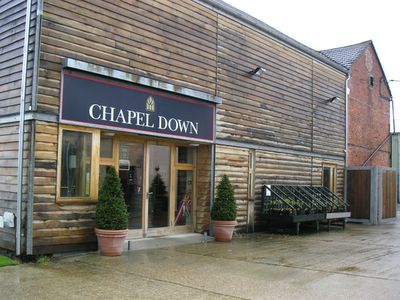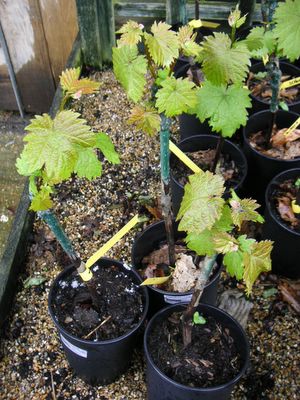
The Chapel Down-vineyard in Kent in Southeastern England.
Straight after the French themselves the English must be the biggest lovers of champagne on Earth. Through several hundred years they have played more than just a secondary role in the development of the champagne, that is today loved globally. The last 20 years even with vineyards and own sparkling wines. The spin-off of a generally warmer world.
It is in counties such as Kent, Sussex and Hampshire, that vines now replace the more traditional orchards. Several hundred vineyards have emerged during the last two or three decades. Today 800 hectares are planted with vines, and the area is only expected to grow. The chalky underground is similar to that of Champagne, the latitude only a few degrees further north, the climate maritime, and the prices of land only a fraction of that in the famous French region.
The similarities are so big and many, that it would seem a deadly sin to bypass them quietly. Well, they don't in England. In the beginning they were flattered when several big houses from hampagne showed interest in the British plonk, today they want to deal with it themselves. And more than one has made it to the very top in international blindtastings and competitions. The tale of the British bubbles is not easy to dismiss. We do not plan to anyway.
Vineyards in Beatrix Potter-country
As we recently drove down England, we chose a detour through what must be the smallest sunken road of Kent, to visit Chapel Down outside the village of Tenterden, with a production of half a million bottles per year today the biggest wineproducer in England.
The never-ending and really dense rain of this weekend is more of a flood than
a shower of spring. But this is England of course. As a good patriot, winegrower and champenois Alain wonders how it is possible to grow and make wine with all this water. Sun - or at least quite a lot of light - after all is necessary to make the photosynthesis - the powerstation of plants - work, so the grapes mature.
But several of the English vineyards grow the three classic Champagne-grapes for the blend of their sparkling wines: Chardonnay, Pinot Noir and Meunier, and their wines certainly are noticed. Both Chapel Down and wineries such as RidgeView Wine Estate and Nyetimber have made it to the top in several international competions and tastings of sparkling wines the last five years.
Each curve on our way to Tenterden seems to hide a beautiful, little English cottage, built in stones, with romantic and slightly oblique attics on the roof, and flowering bushes on juicy green lawns. Each moment I expect to see Peter Rabbit himself pull the wall of leaves aside to put out his curious little head to see who they are, these French disturbers of peace in his little kingdom of streams, trees, bushes and a road, hardly broader than a meter and very much with the resemblance of a green tunnel.
But as we arrive, there is no faded Victorian charm at all at the Chapel Down. In Tenterden big signs at the road show the way to the vineyard, and as we leave the car at the very spacy parking, we understand, that this is not an accidental hectare or two with a bit of vines for the fun of it. This is big business, and it is pulls all strings possible when it comes to wines, gastronomy and tourism.

On top of guided paid tours, own wines, English specialities Chapel Down also sells young plants.
Unfortunately we have a ferry to catch, so we can only spend few minutes running through the shop, elegantly covered with noble wood. This is so far from a classic farmshop or even an acceuil as we know them in Champagne. This is a temple of savour and tastiness. On top of the red, white, rosé and sparkling wines of the estate you can also buy culinary, British specialities such as pickles and Cumberland-sauce and delicatessen from the continent like tapenades and different mustards and vinegars. All is expensive. People who use this kind of tasty ingredients, when they cook, probably already know that they will have to pay for it.
So that is what we do - one glass of Cumberland-sauce is four pounds - and some sparklers of the house at twenty something pounds for the most expensive. Thus it is hardly on the price that the British bubbly will compete with the real champagnes, that are sold from 10 pounds for the cheapest bottles in British supermarkets. But maybe on the taste then.
Interest from Champagne
The many medals and growing recognition have brought a certain arrogance along with it. Wellknown champagne houses as well as the CIVC have had people in England to study the possibilities. However so discrete that none has commented directly in the many media who has so far published stories about the British bubbles.
Maybe smaller winegrowers have less prestige to loose. Anyway winegrower Pierson Whitaker of Avize earlier this year told British newsagency Reuters about his plans to plant vines on 12 hectares of good English soils in the Meon Valley in Hampshire. Whitaker already has vines in the Grand Cru-village Avize in the Côte des Blancs south of Épernay. His plan is to make 15.000 bottles of English fizz using the same principles as in Champagne.
In what atmosphere the visits of the big houses in Southern England takes place, I do not know. I just note that the lady at the counter in the shop of Chapel Down really does not want to talk to somebody from Champagne. On our side however we are curiois to taste the fizz of Chapel Down - a clear brut (Rivaner, Reichensteiner and Pinot Noir) and a rosé brut (100% Pinot Noir). So far they still wait for a suitable occasion in our cave.
På dansk
Copyright: The copyright for text and photos at bobler.blogspot.com belongs to Solveig Tange. You may use my articles, photos or parts of them for non-commercial use and if I am credited as the author. Feel free to link to this site but not in your own frameset please.
No comments:
Post a Comment